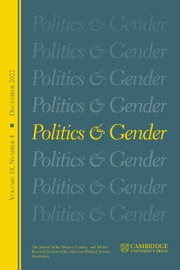Crossref Citations
This article has been cited by the following publications. This list is generated based on data provided by
Crossref.
Hughes, Melanie M.
and
Paxton, Pamela
2007.
Familiar Theories from a New Perspective: The Implications of a Longitudinal Approach to Women in Politics Research.
Politics & Gender,
Vol. 3,
Issue. 3,
p.
370.
Gershon, Sarah Allen
2008.
Communicating Female and Minority Interests Online: A Study of Web Site Issue Discussion among Female, Latino, and African American Members of Congress.
The International Journal of Press/Politics,
Vol. 13,
Issue. 2,
p.
120.
Cheng, Christine
and
Tavits, Margit
2011.
Informal Influences in Selecting Female Political Candidates.
Political Research Quarterly,
Vol. 64,
Issue. 2,
p.
460.
Frederick, Brian
2011.
Gender Turnover and Roll Call Voting in the US Senate.
Journal of Women, Politics & Policy,
Vol. 32,
Issue. 3,
p.
193.
MacDonald, Jason A.
and
O'Brien, Erin E.
2011.
Quasi-Experimental Design, Constituency, and Advancing Women’s Interests: Reexamining the Influence of Gender on Substantive Representation.
Political Research Quarterly,
Vol. 64,
Issue. 2,
p.
472.
Pearson, Kathryn
and
Dancey, Logan
2011.
Elevating Women’s Voices in Congress.
Political Research Quarterly,
Vol. 64,
Issue. 4,
p.
910.
Wilson, Walter Clark
and
Carlos, Roberto Felix
2014.
Do Women Representatives Regender Legislative Bureaucracy? Assessing the Effect of Representative Sex on Women's Presence among US Congressional Staff.
The Journal of Legislative Studies,
Vol. 20,
Issue. 2,
p.
216.
Sundstrrm, Aksel
Paxton, Pamela
Wang, Yi-ting
and
Lindberg, Staffan I.
2015.
Women's Political Empowerment: A New Global Index, 1900-2012.
SSRN Electronic Journal,
Evans, Heather K.
Ovalle, Joycelyn
and
Green, Stephen
2016.
Rockin' robins: Do congresswomen rule the roost in the Twittersphere?.
Journal of the Association for Information Science and Technology,
Vol. 67,
Issue. 2,
p.
268.
Swers, Michele L.
2016.
Pursuing Women’s Interests in Partisan Times: Explaining Gender Differences in Legislative Activity on Health, Education, and Women’s Health Issues.
Journal of Women, Politics & Policy,
Vol. 37,
Issue. 3,
p.
249.
Cormack, Lindsey
2016.
Gender and vote revelation strategy in the United States Congress.
Journal of Gender Studies,
Vol. 25,
Issue. 6,
p.
626.
Lupton, Danielle L.
Parsa, Sahar
and
Schuster, Steven Sprick
2017.
Widows, Congressional Representation, and the (Ms.)Appropriation of a Name.
SSRN Electronic Journal,
Sommer, Udi
2017.
Women, Demography and Politics: How Lower Fertility Rates Lead to Democracy.
SSRN Electronic Journal ,
Purtle, Jonathan
Goldstein, Neal D.
Edson, Eli
and
Hand, Annamarie
2017.
Who votes for public health? U.S. senator characteristics associated with voting in concordance with public health policy recommendations (1998–2013).
SSM - Population Health,
Vol. 3,
Issue. ,
p.
136.
Barnes, Tiffany D.
and
Cassese, Erin C.
2017.
American Party Women.
Political Research Quarterly,
Vol. 70,
Issue. 1,
p.
127.
Curry, James M.
and
Haydon, Matthew R.
2018.
Lawmaker Age, Issue Salience, and Senior Representation in Congress.
American Politics Research,
Vol. 46,
Issue. 4,
p.
567.
Laperrière, Marie
and
Orloff, Ann Shola
2018.
Handbook of the Sociology of Gender.
p.
227.
Sommer, Udi
2018.
Women, Demography, and Politics: How Lower Fertility Rates Lead to Democracy.
Demography,
Vol. 55,
Issue. 2,
p.
559.
Sanders, Bailey
2018.
Partisan Bridges to Bipartisanship: The Case of Contraceptive Coverage.
Legislative Studies Quarterly,
Vol. 43,
Issue. 3,
p.
521.
Itzkovitch-Malka, Reut
and
Friedberg, Chen
2018.
Gendering security: The substantive representation of women in the Israeli parliament.
European Journal of Women's Studies,
Vol. 25,
Issue. 4,
p.
419.


